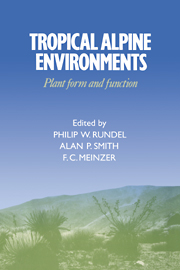Book contents
- Frontmatter
- Contents
- List of contributors
- Preface
- 1 Introduction to tropical alpine vegetation
- 2 Tropical alpine climates
- 3 Páramo microclimate and leaf thermal balance of Andean giant rosette plants
- 4 Comparative water relations of tropical alpine plants
- 5 Cold tolerance in tropical alpine plants
- 6 Anatomy of tropical alpine plants
- 7 Environmental biology of a tropical treeline species, Polylepis sericea
- 8 Morphological and physiological radiation in páramo Draba
- 9 Sediment-based carbon nutrition in tropical alpine Isoetes
- 10 Functional significance of inflorescence pubescence in tropical alpine species of Puya
- 11 Turnover and conservation of nutrients in the pachycaul Senecio keniodendron
- 12 Soil nutrient dynamics in East African alpine ecosystems
- 13 An overview of the reproductive biology of Espeletia (Asteraceae) in the Venezuelan Andes
- 14 Population biology of Mount Kenya lobelias
- 15 Population biology of Senecio keniodendron (Asteraceae), an Afroalpine giant rosette plant
- 16 Population dynamics and flowering in a Hawaiian alpine rosette plant, Argyroxiphium sandwicense
- 17 Plant form and function in alpine New Guinea
- 18 Alpine herbivory on Mount Kenya
- 19 Biotic interactions in Hawaiian high elevation ecosystems
- 20 Tropical alpine ecology: progress and priorities
- Index
20 - Tropical alpine ecology: progress and priorities
Published online by Cambridge University Press: 21 October 2009
- Frontmatter
- Contents
- List of contributors
- Preface
- 1 Introduction to tropical alpine vegetation
- 2 Tropical alpine climates
- 3 Páramo microclimate and leaf thermal balance of Andean giant rosette plants
- 4 Comparative water relations of tropical alpine plants
- 5 Cold tolerance in tropical alpine plants
- 6 Anatomy of tropical alpine plants
- 7 Environmental biology of a tropical treeline species, Polylepis sericea
- 8 Morphological and physiological radiation in páramo Draba
- 9 Sediment-based carbon nutrition in tropical alpine Isoetes
- 10 Functional significance of inflorescence pubescence in tropical alpine species of Puya
- 11 Turnover and conservation of nutrients in the pachycaul Senecio keniodendron
- 12 Soil nutrient dynamics in East African alpine ecosystems
- 13 An overview of the reproductive biology of Espeletia (Asteraceae) in the Venezuelan Andes
- 14 Population biology of Mount Kenya lobelias
- 15 Population biology of Senecio keniodendron (Asteraceae), an Afroalpine giant rosette plant
- 16 Population dynamics and flowering in a Hawaiian alpine rosette plant, Argyroxiphium sandwicense
- 17 Plant form and function in alpine New Guinea
- 18 Alpine herbivory on Mount Kenya
- 19 Biotic interactions in Hawaiian high elevation ecosystems
- 20 Tropical alpine ecology: progress and priorities
- Index
Summary
As physiological plant ecologists and population biologists continue to work in tropical alpine environments, our knowledge of the form and functional relationships will surely grow rapidly. These ecosystems present unusual challenges for plant establishment and survival, but remain poorly studied. In this closing chapter, we briefly review what we feel are the important accomplishments to date in tropical alpine ecology and the challenges that remain. We focus on plant growth forms, plant demography, physiological convergence, ecosystem function and global climate change.
Plant growth forms
The most striking aspect of tropical alpine habitats is the diversity of plant growth forms, and the apparent convergence between geographically disjunct tropical mountains with respect to these forms (Hedberg & Hedberg 1979; Rauh 1978). Much progress has been made in understanding the ecological and physiological significance of the giant rosette form, perhaps the most conspicuous and typical form of high tropical mountains. However, the majority of tropical alpine growth forms have not been subject to quantitative and experimental analysis. Sclerophyllous-leaved shrubs, cushion plants, tussock grasses and acaulescent rosette forms have received minimal attention. Species in each of these forms may respond differently to changing environmental conditions, and may contribute in very different ways to edaphic, microclimatic and biotic environments.
Classical ecological paradigms suggest the evolution will lead toward convergence in adaptive traits of morphology, phenology, and physiology which provide the ‘best’ ecological solution to similar environmental stresses in disjunct habitats.
- Type
- Chapter
- Information
- Tropical Alpine EnvironmentsPlant Form and Function, pp. 355 - 364Publisher: Cambridge University PressPrint publication year: 1994
- 7
- Cited by

